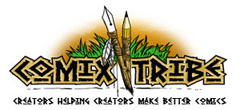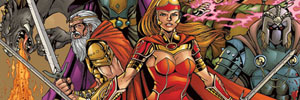Archive for October 7th, 2010
Creating Great Characters Part II
…(Or Why Wolverine is Everywhere)
(Note: This column first appeared last year in Tyler James’ Creating Comics! The Art + Craft column at Comic Related.)
Last time, we discussed the qualities of great comic book characters. I’ve been using a certain short, hairy mutant with an adamantium laced skeleton as an illustrative example of these concepts. Once again, I’ll plug Scott McCloud’s excellent book “Making Comics” as a must have for your comics library and as providing some structure for this piece. In the first part of this article, I discussed two qualities of great characters: An inner life and visual distinction. Now let’s turn to the third characteristic- expressive traits.
 3. Expressive Traits- This is often the hardest one to nail down. If you’re a strong and creative artist, you can probably come up with a killer costume design without too much trouble. And if you’re a good writer, you can dream up a fabulous inner life for a character by simply asking and answering good questions about them. But all that will be for naught if all your characters walk, talk, fight, make love, etc. JUST LIKE YOU. Sorry, but you’re just not that interesting.
3. Expressive Traits- This is often the hardest one to nail down. If you’re a strong and creative artist, you can probably come up with a killer costume design without too much trouble. And if you’re a good writer, you can dream up a fabulous inner life for a character by simply asking and answering good questions about them. But all that will be for naught if all your characters walk, talk, fight, make love, etc. JUST LIKE YOU. Sorry, but you’re just not that interesting.
As writers, we need to recognize that the default voice we’ll lend our characters is almost always going to be our own. Do that though, and all your characters might look different, but will come across as oddly similar. And it’s the differences in characters that create conflict, and thus make for interesting situations and stories.
When thinking about expressive traits, think about body language, speech patterns, key expressions, and common poses. All the great characters have them. Homer Simpson has his “D’oh!” Charlie Brown has “Good grief.” Ebeneezer Scrooge has “Bah Humbug!” House has his cane and awful bedside manner. Kramer has more expressive traits than I could post here. “Giddy up!” What are your characters’ expressive traits? What’s going to make them stand out from the pack?
The expressive traits you choose for your characters should derive from the inner life you’ve generated for your character. His or her background or where they’re from should impact the way they talk and the expressions they use. Spend some time and do your homework on this. If your character is from Australia, don’t think you can just replace the word “friend” with “mate” and call it a day. Find some people with similar backgrounds and really listen to how they put their words together and what expressions they use, beyond the most stereotypical stuff you see on TV.
How does Wolverine stack up in the expressive traits category? Pretty well, I think. Be it calling friends and foes “Bub,” chomping on a cigar, or his trademark “SNKKKT,” when the claws come out, there are plenty of ways Logan can make an impact on a scene. And that’s really what it’s all about. Characters with expressive traits STAND OUT. And they’ll make your stories stand out, too.
So, now you know Scott McCloud’s secret for making good characters. It’s served me well, and hopefully it’ll serve you well, too. One tool that I’ve been using lately to help me flesh out my characters is a Character Grid. What I do is make a table in MS Word or Google Docs, or even just a sheet of loose-leaf. In each row, down the first column of the table, I list important questions I should answer about my characters. Each column of the table contains the names of major characters in my story. For each character, I answer the questions to help reveal their character.
Here’s an example of the types of questions I’ll put in my grid, filled out with two characters from Over my romantic comedy online graphic novel. On the one hand, both of these characters serve a similar purpose in the story- they’re friends with the main character, Felix, and there to help him pull his life back together after a tough break-up. However, using the character grid, I was able to make sure that the two characters were very different in just about all other ways.
| CHARACTER | Tony | Skate |
| Full Name | Tony Tuttle | Malcolm “SK8” Skaton |
| Role/Purpose | Tough love for Felix, Kick in the Ass | Comforts the protagonist, encourages him to “get back in the game” |
| Age/Sex/Race | 48, M, White | 23, M, Black |
| Main Goal | Get Felix to finish issue 12 of “Fire of the Pendragon,” Keep Blam! Comics in business | Wants to be a top comic artist, work for DC/Marvel |
| Occupation | President and EIC of Blam! Comics | Comic artist, Pizza Delivery Boy |
| Motivation | Build Blam! Comics into a respected comics powerhouse | Prove to his brother and parents he can make it as an artist |
| Inner Need | Respect in the Comics Industry | Validation as an artist |
| Flaw | Rough exterior but gentle soul, worried not cutthroat enough a business man to make it in comics, poor people skills | Outwardly cocky, but inwardly lacks confidence; young and fears being taken advantage of |
| Backstory | Ultimate comics fanboy, but never the talent to create them himself. Worked for family accounting firm, when parents died, he sold the business to start Blam! Comics. Three years and the business has yet to turn a profit. “Fire of the Pendragon” is his only profitable title. | Has been sketching and drawing comics since a trip to Comic Con at 8 years old. Met up with Felix at a con who got him to draw his fantasy comic. Has been waiting patiently for the last 2.5 months for the script for issue 12, but Felix has been MIA. He thinks Felix is trying to replace him with another artist. |
| Core Trait | Rational, Mr. Dollars and Cents | A fighter |
| Good/Bad Habits | Overweight and eats too much. High strung and drinks too many Redbulls. | Nice guy, but mischievous. Can fly off the handle, overly sensitive |
| Secret | Has been chipping away at his inheritance and life savings to support Blam! | Wishes his parents respected him as much as they respect his older brother. |
| Skills, Knowledge, Props | Knows business matters very well, LOVES comics and reads more than just about anyone. | Outstanding artist with unlimited potential. |
| Quirks | Drinks a lot of Redbull. Uses a lot of comics book references. | Always has a sketchpad on him. Usually has ipod earbuds in. |
| Attitude | Gruff | Defensive |
| Dialogue Style | Blunt and to the point. No sugar coating his words. | A fast talker. Some urban slang thrown in, but educated, middle-class, New England background. |
| Celebrity Look alike | Dennis Franz | Bow Wow |
 The great thing about doing the grid is that it allows you to see all of your main characters together in one spot. This makes it easy to see where certain characters may be redundant, and you can make changes. Feel free to borrow my grid, and definitely add your own categories.
The great thing about doing the grid is that it allows you to see all of your main characters together in one spot. This makes it easy to see where certain characters may be redundant, and you can make changes. Feel free to borrow my grid, and definitely add your own categories.
The character grid also reminds you that it’s important to flesh out ALL of your characters, even the supporting ones. There’s some stuff in the grid above, such as the fact that Tony’s bleeding his own bank account dry to support Blam! Comics that will never make it into the graphic novel. However, that fact colors Tony’s actions and reactions to the other characters, and makes him easier to write. It can’t just be your main character who has goals and wants and desires. All of your characters should have these things.
From the information in this grid, it was fairly easy to come up with decent character design sketches. As an artist, character design is not one of my strong suits, but I’m fairly happy with how this first stab at a design for Skate and Tony came out.
Remember, when you’re creating your stories, you’re creating stories FOR HUMAN BEINGS. As a result, the most important part of your stories is the characters that inhabit them. While I said that it’s damn hard to create make-believe characters that your readers will identify and care about, the funny thing is, your readers WANT TO CARE. They wouldn’t be picking up a comic or popping on a movie if they didn’t want a break from their own problems or the real people in their lives’ petty concerns, in order to see what someone make believe is dealing with. Use that to your advantage. Flesh out your characters by giving them an inner life, visual distinction, and expressive traits, and watch your readers respond.









#30Characters Chatter…